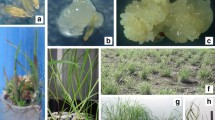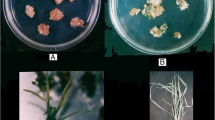Abstract
An in vitro selection method was developed for Coleus blumei to enhance salt tolerance of this amenity species. Leaf disc explants were incubated on a Murashige & Skoog medium containing benzylaminopurine, 2 mg l-1, and napthalene acetic acid, 1 mg l-1, which initiated both callus and plantlets from the explants. A large number of explants were incubated on this differentiating medium containing 90 mM NaCl, which inhibited over 90% of plantlet formation. Surviving plantlets. were grown to maturity, when apical cuttings were taken and propagated. Plants were also allowed to flower and set seed. Cuttings from the selected regenerated plants showed consistently better growth in the presence of NaCl than unselected cuttings. Seed progeny of selected plants also showed more vigorous growth in the presence and absence of NaCl than progeny from unselected plants. The in vitro selection was compared with the results of an earlier in vivo selection to assess the contribution from tissue culture derived somaclonal variation. Progeny from the in vitro selection showed a higher level of tolerance than progeny from the in vivo selection.
Similar content being viewed by others
References
Larkin PJ & Scowcroft WR (1981) Somaclonal variation: a novel source of variability from cell cultures for plant improvement. Theor. Appl. Genet. 60: 197–214
Karp A & Bright SWJ (1985) On the causes and origins of somaclonal variation. In: Miflin BJ (Ed) Oxford Surveys of Plant Molecular and Cell Biology, Vol 2 (pp 199–234). Oxford University Press, Oxford
Wenzel (1985) Strategies in unconventional breeding for disease resistance. Ann. Rev. Phytopath. 23: 149–172
Daub ME (1986) Tissue culture and the selection of resistance to pathogens. Ann. Rev. Phytopath. 24: 159–186
Banks-Izen MS & Polito US (1980) Changes in ploidy level in callus derived from two growth phases of Hedera helix L. the English Ivy. Plant Sci. Lett. 18: 161–167
Lorz H & Scowcroft WR (1983) Variability amongst plants and their progeny regenerated from protoplasts of Su/su heterozygotes of Nicotiana tabacum. Theor. Appl. Genet. 66: 67–75.
Collin HA & Dix PJ (1990) Culture systems and selection procedures. In: Dix PJ (Ed) Plant Cell Line Selection. Procedures and Applications (pp 3–18). VCH, Weinham, Germany
Nabors MW, Gibbs SE, Bernstein CS & Meis ME (1980) NaCl-tolerant tobacco plants from cultured cells. Zeitschrift Pflanzenphysiol. 97: 13–17
Bhaskaran S, Smith RH & Schertz KF (1986) Progeny screening of Sorghum plants regenerated from sodium chloride selected callus for salt tolerance. J. Plant Physiol. 122: 205–210
McCoy TJ (1987) Characterization of alfalfa (Medicago sativa L.) plants regenerated from selected NaCl tolerant cell lines. Plant Cell Rep. 6: 417–422
McHugen A (1987) Salt tolerance through increased vigour in a flax line (STS-II) selected for salt tolerance in vitro. Theor. Appl. Genet. 74: 722–732
Vajrabhaya M, Tharapaisol T & Vajrabhaya T (1989) Development of salt tolerant lines of KDML and LPT rice cultivars through tissue culture. Plant Cell Rep. 8: 411–414
Merrick MMA & Collins HA (1982) Asulam resistance in embryoids of celery tissue cultures. New Phyt. 92: 435–439
Francois LE (1982) Salt tolerance of eight ornamental tree species. J. Amer. Soc. Hort. Sci. 20: 1102–1104
Sonneveld C & Voogt W (1983) Studies on the salt tolerance of some flower crops grown under glass. Plant and Soil 74: 41–52
Murashige T & Skoog F (1962) A revised medium for rapid growth and bioassays with tobacco tissue cultures. Physiol. Plant. 15: 473–497
Hoagland DR & Arnon DI (1950) The water culture method of growing plants without soil. University of California, Berkeley College of Agriculture, Circular No. 347
Razzaque A & Ellis BE (1977) Rosmarinic acid production in Coleus cultures. Planta 137: 287–291
Gamborg OL, Miller RA & Ojima K (1968) Plant cell cultures. I Nutrient requirements of suspension cultures of soyabean root cells. Expt. Cell Res. 50: 151–158
Al-Abta S & Collin HA (1978) Cell differentiation in embryoids and plantlets of celery tissue cultures. New Phyt. 80: 517–521
Nabors MW (1990) Environmental stress resistance. In: Dix PJ (Ed) Plant Cell Line Selection: Procedures and Applications (pp 167–180). VCH Weinhem, Germany
Ibrahim KM, Collins JC & Collin HA (1991) In vivo selection for salt tolerance in Coleus blumei. J. Hort. Sci. (in press)
Author information
Authors and Affiliations
Rights and permissions
About this article
Cite this article
Ibrahim, K.M., Collins, J.C. & Collin, H.A. Characterization of progeny of Coleus blumei following an in vitro selection for salt tolerance. Plant Cell Tiss Organ Cult 28, 139–145 (1992). https://doi.org/10.1007/BF00055508
Received:
Accepted:
Issue Date:
DOI: https://doi.org/10.1007/BF00055508




